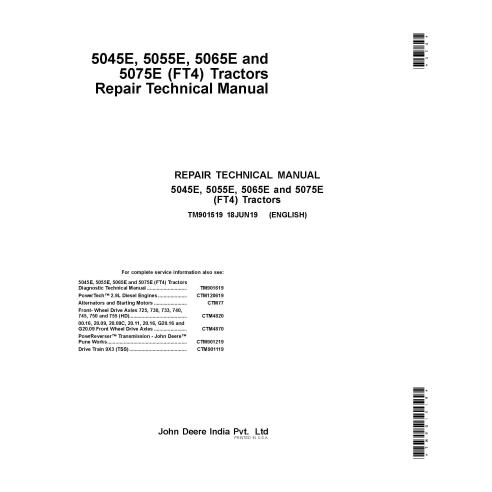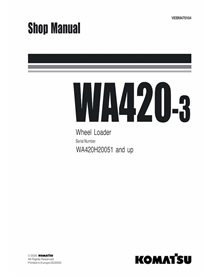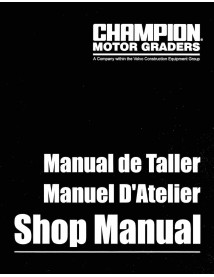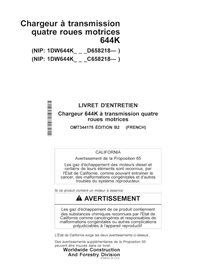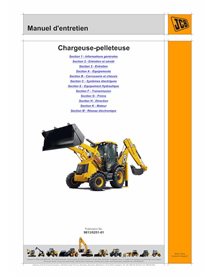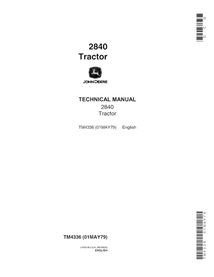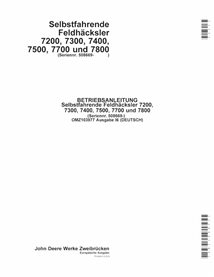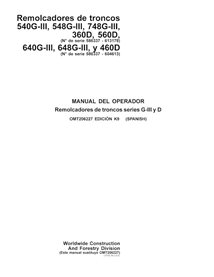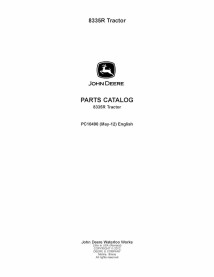John Deere 5045E, 5055E, 5065E, 5075E tractor pdf repair technical manual
Format: PDF
Pages: 534
File size: 8.65 MB
Language: English
Models: 5045E, 5055E, 5065E and 5075E (FT4) MY2014 - MY2017
Repair technical manual for 5045E, 5055E, 5065E, 5075E tractor is available for instant download after purchase at any time. It can be downloaded and viewed on any device. Download free preview PDF file using the link in Attachments TAB
John Deere 5045E, 5055E, 5065E, 5075E tractor pdf repair technical manual is available for instant download after purchase. Download a free preview pdf file of the original document, and decide whether it suits your needs. This preview file in the Attachments section includes the initial part of the main document, about 5% of the pages, and you may get acquainted with the contents of the document.
Deere & Company, better known under the John Deere brand, is an American engineering company headquartered in Moline, Illinois, engaged in the production of agricultural, construction and forestry machinery, engines and transmissions.
Agricultural machinery: tractors, grain harvesters, cotton harvesters, balers, planters, forage harvesters and sprayers.
Construction machinery: Excavators, Loaders, Graders, Backhoe Loaders, Bulldozers.
Logging equipment: The company produces a whole line of forestry equipment.
Other products and services: In addition to heavy equipment, Deere & Company also manufactures consumer and commercial equipment, including lawn mowers, snow blowers, snowmobiles, and all-terrain vehicles. The company is also a supplier of diesel engines and power units (axles, transmissions, etc.) used in heavy machinery.
All this equipment needs timely and proper maintenance. Our manuals will be useful for the use, maintenance and repair of John Deere equipment.
Today, John Deere is known for its award-winning innovations, but have you ever really thought about how we got here? The most critical moments in John Deere history date back to 1837 when the man himself, John Deere, was a blacksmith in Grand Detour, IL who wanted to make farmers’ jobs a bit easier.
Fast forward over 180 years, and this company is still manufacturing equipment with the same purpose in mind – helping customers be as productive as possible. While Deere is widely known for its various tractor models, these machines were not being produced until 1918 – this is when the company purchased the Waterloo Engine Gas Company.
In addition to producing various types of equipment throughout the years, this company has also seen various leaders, logos, and factories over time. It is these individual moving parts that have made John Deere history so fascinating to reflect on. With an ongoing commitment to innovation, agriculture, and people, Deere has had no shortage of amazing breakthroughs that have established where it is today and where it will be in the future.
Let’s take a closer look at these moments in John Deere history.
Who Invented John Deere?
John Deere the company would not have been possible without the determination of John Deere the man. From the time he created the first steel plow in 1837, Deere was committed to helping farmers handle their daily tasks with ease. As demand for these plows rose, Deere moved the business from Grand Detour to Moline, IL in 1848 due to the power and transportation benefits this new location offered. Just two years later, around 1600 plows had been produced and John Deere began to expand its range of equipment, including the first ride-on plow, the Hawkeye Riding Cultivator, which relied on horses. This implement was first introduced at the Iowa State Fair in 1863.
As we look back on moments like these in John Deere history, it is critical to understand those who were at the forefront of this success.
Charles Deere (1886 – 1907)
The second son of John Deere, Charles Deere, took over leadership in 1886 before his father’s passing that same year. During his time as head of the company, Deere used his experience as a top salesman to establish John Deere’s first branch house in Kansas City. These branch houses “provided valuable information from the field that influenced new product development”. By the time of his death in 1907, Charles Deere played a central role in John Deere history by helping the company become one of the top implement makers in the country.
William Butterworth (1907 – 1936)
Just 15 years after joining Deere & Company as an assistant buyer, William Butterworth, son-in-law of Charles Deere, became president of John Deere in 1907. Under his leadership, 11 factories and 25 sales organizations were consolidated into one entity – this led to the development of the modern Deere & Company. The overall product line continued to expand during his time as head of the company; this includes entry into the combine harvester market in 1912 and the tractor business in 1918 through the purchase of the Waterloo Engine Gas Company. Once retiring in 1928, Butterworth became the company’s first chairman of the board and was elected to the US Chamber of Commerce before his death in 1936.
Charles Deere Wiman (1928 – 1955)
As the great-grandson of John Deere, Charles Deere Wiman started at the company as a line employee and eventually advanced to become president in 1928 with the retirement of his uncle, William Butterworth. Despite hardships resulting from the Great Depression, Wiman worked hard to ensure John Deere would continue its success. This led to the introduction of the famous Model “A” tractor in 1934, which was followed closely by the Model “B” the following year. Without this sense of dedication to the company, this important piece of John Deere history would cease to exist.
William Hewitt (1955-1982)
Just two years after joining Deere & Company as a territory manager in California, William Hewitt was named director in 1950 and became president after Charles Deere Wiman, Hewitt’s father-in-law, passed in 1955. From this point forward, the company began to establish itself as a multinational company, purchasing a share of a tractor company in Mannheim, Germany and acquiring land in Monterrey, Mexico in 1956. As John Deere expanded its global reach, the company also welcomed new four- and six-cylinder tractors under Hewitt’s leadership. These models – called the “New Generation of Power” – were officially introduced in 1960.
Robert Hanson (1982-1990)
Despite not being related to the man himself, Robert Hanson was still able to leave his mark within John Deere history. Hanson was named the president of Deere & Company in 1978 before being elected chairman and CEO following William Hewitt’s retirement in 1982. In the midst of difficult recessions in the 1980s, Hanson helped the company not only stay afloat but also exceed sales expectations. This positive trend continued and saw John Deere enter the health care market in 1985 with the formation of John Deere Health Care, Inc.
Hans Becherer (1990 – 2000)
Once elected as chairman of Deere & Company in 1990 upon Robert Hanson’s retirement, Hans Becherer stressed values that have played key roles in John Deere history since the creation of the first steel plow. A dedication to constant innovation and global growth enabled immense changes, such as the formation of a separate operating division for Deere’s lawn-and-grounds-care equipment operations. During Becherer’s tenure, the company continued to lead when it came to new ag technology and precision farming. Additionally, Deere & Company entered a long-term relationship with the PGA and opened the John Deere Pavilion in 1997 under his leadership.
Robert W. Lane (2000 – 2009)
Having managed a range of operations within the Worldwide Construction EquipmentDivision, Robert W. Lane had an understanding of what it would take to help Deere & Company attain maximum global growth. By establishing the SVA (Shareholder Value Added) model, the company was able to achieve world-class status in asset efficiency and ROI. This included modernizing traditional factories around the world and ensuring dealer organizations were upgraded in order to better meet customer demands. Upon his retirement as Chairman of Deere & Company’s Board of Directors in 2009, Lane was succeeded by Deere’s current Chairman and CEO, Samuel R. Allen.
Where is the John Deere Factory Located?
As customer demands evolve, John Deere factory locations across the world are designed to keep up. There are over 100 factories in more than 30 countries today.
As John Deere factory workers today help produce equipment for agriculture, lawn care, construction, outdoor recreation, and forestry, we should look back at those moments that helped this company stand the test of time.
- 1848: The company moved from its birthplace in Grand Detour, IL to Moline, IL due to the latter’s water, power, and transportation advantages.
- 1887: The Deere & Mansur Company, formed by Charles Deere and Alvah Mansur, a business partner of the Deere family, is a top manufacturer of planters. Due to the success of this division, Deere & Mansur moved from a small two-story building in Moline to a larger location once production became more significant.
- 1913: Under the leadership of William Butterworth, the company enters the harvesting business with a new factory, a critical moment in John Deere history. John Deere Harvester Works, which still produces S-Series combines and a variety of front-end equipment, would continue on to become one of the top John Deere factory locations for over a century.
- 1918: John Deere history is made when it enters the tractor business through the purchase of the Waterloo Gas Engine Company. This quickly proves to be a success, with Deere producing and selling 5,634 tractors in the first year.
- 1947: The John Deere Dubuque Works factory opened its doors and begins to produce a large percentage of the company’s construction and forestry equipment.
- 1948: In 1941, during WWII, the US government constructs the Des Moines Ordnance Plant in order to produce ammunition. Once the war concluded, John Deere purchased an industrial area of the plant which later turned into the Des Moines Works factory.
When did John Deere change their logo?
When it comes to understanding John Deere history, it is important to understand how branding within this company has changed to reflect changes across the business as a whole. Let’s explore these changes and take a deeper dive into the evolution of the John Deere logo.
- 1864: Once receiving its first patent, John Deere establishes itself as a force to be reckoned with in the world of manufacturing.
- 1876: As the company started to produce more equipment, they required a trademarkto defend against copying and deception. This John Deere logo was just the beginning of many designs to come as the company grew larger and entered new industries.
- 1912: Deere starts to produce planters, buggies, wagons, grain drills, and hay and harvesting equipment. The statement “The Trade Mark of Quality Made Famous by Good Implements” makes its first appearance on the new logo, which includes more detail than the original.
- 1936: In an effort to standardize processes while manufacturing equipment, this new logo removed some of the details from the previous logo – this made stenciling onto products easier.
- 1937: As Deere’s sales continue to increase, a new, simpler logo is introduced. This could be due to the fact that the trademark was being used in more places or that it was the company’s 100th anniversary that year.
- 1950: This logo set the stage for future logos in regards to the text, the slogan, the deer itself, and the removal of “Moline, IL” due to the company expanding its reach throughout the years.
- 1956: As Deere broke out into other industries, such as construction, the slogan “Quality Farm Equipment”, which was established in 1950, was dropped. “John Deere” was also placed under the leaping Deere for the first time.
- 1968: This new contemporary John Deee logo was designed for better reproduction and readability as the company continued to grow across all divisions.
- 2000: The creation of this current logo saw the addition of color and a change in the way the Deere is leaping – it is now leaping forwards instead of landing.
What all does John Deere make?
At the end of the day, key moments in John Deere history heavily revolve around the equipment. Since creating the first steel plow in 1837, the company has continuously produced machines that are changing the game. Here are some key points in time that stand out.
- 1912: Deere & Company introduces planters, buggies, wagons, grain drills, and hay and harvesting equipment to its product lineup.
- 1918: In the midst of building a tractor that could be sold for under $700, John Deere purchases the Waterloo Gasoline Engine Company. This was known as the John Deere Waterloo Boy N.
- 1927: The company introduces its first combine.
- 1934: John Deere’s first row crop tractor, the Model A, is introduced and followed one year later by the Model B.
- 1947: The Model M tractor is manufactured at John Deere Dubuque Works and eventually evolves into a bulldozer. This transformation kickstarts the company’s entry into the construction and forestry businesses.
- 1950: The No. 8 Cotton Picker is the first two-row self-propelled machine on the market.
- 1957: Haying becomes a one-man operation for the first time when the 14T baler is introduced. This piece of equipment produces twine-tied bales, improving overall productivity and ease of use.
- 1963: John Deere’s Consumer Equipment division enters the market with lawn and garden tractors in addition to attachments.
- 1992: John Deere & Company introduces its first Gator, the Gator TH. Despite originally being produced for light tasks, such as landscaping, this original Gator helped pave the way for those XUVs we enjoy today.
- 1994: The 8000 Series tractor makes its debut and establishes new standards in control, visibility, maneuverability, and power.
- 1996: John Deere makes history when it introduces the 7760 Cotton Picker, the first of its kind to build round cotton modules on the go.
Over the past century, John Deere has continued to evolve and find success along the way. Through different forms of leadership, logo designs, factory locations, and equipment production, this company has been able to stand out and prove itself time and time again. By looking back at John Deere history, we can prepare ourselves for all that it has to hold in the future.
Less
